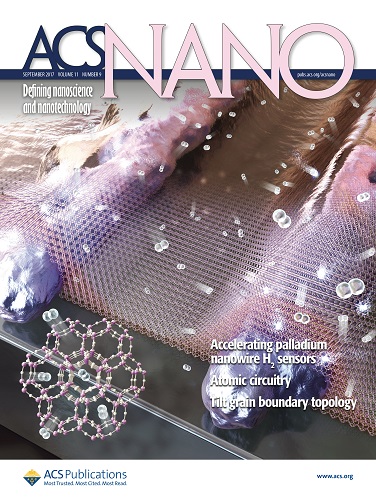Highlight
| Intro | A research group under Prof. Il-Doo Kim in the department of Materials Science and Engineering at Korea Advanced Institute of Science and Technology (KAIST) has developed an ultra-fast hydrogen gas detection system based on palladium (Pd) nanowire array coated with metal-organic framework (MOF) through the international collaboration with Prof. Reginald M. Penner in the department of Chemistry at University of California-Irvine. With this technology, 1 vol% of hydrogen gas can be rapidly detected in just 7 seconds. |
|---|---|
| Principal Investigator | Prof. Il Doo Kim |
| Date | 2017-09-26 |
□ A research group under Prof. Il-Doo Kim in the
department of Materials Science and Engineering at Korea Advanced Institute of
Science and Technology (KAIST) has developed an ultra-fast hydrogen gas
detection system based on palladium (Pd) nanowire array coated with
metal-organic framework (MOF) through the international collaboration with
Prof. Reginald M. Penner in the department of Chemistry at University of
California-Irvine. With this technology, 1 vol% of hydrogen gas can be rapidly
detected in just 7 seconds.
□ Hydrogen has been regarded as an eco-friendly next-generation
energy source, but it is a flammable gas that can cause an explosion even in
small sparks. Since the lower explosion limit for hydrogen gas is 4 vol%, for
safety, the sensors should detect the colorless and odorless hydrogen molecule
quickly. The importance of sensors capable of rapidly detecting colorless and
odorless hydrogen gas has been emphasized in recent guidelines issued by the
U.S. Department of Energy that dictate that hydrogen sensors should detect 1
vol% of hydrogen in air in less than 60 seconds for response and recovery time.
□ Since the resistance change by the reaction of Pd
with hydrogen gas is known in the 1960s, enormous efforts have been made to
develop a Pd-based resistor-type hydrogen gas sensor. However, due to the
influence of disturbing gases such as oxygen in the air, the performance of Pd
based hydrogen sensors has not reached the level of commercialization.
□ A research team of Prof. Il-Doo Kim and Prof.
Reginald M. Penner has developed an ultra-sensitive and ultra-fast hydrogen
sensor that can detect hundreds of part per million levels of hydrogen gas
within 60 seconds at room temperature.
□ To overcome the limitations of Pd based hydrogen
sensors, the research team introduced a MOF layer on top of a Pd nanowire
array. Lithographically patterned Pd nanowires were simply overcoated with a Zn
based zeolite imidazole framework (ZIF-8) layer composed of Zn ions and organic
ligands. ZIF-8 film is easily coated on Pd nanowires by simple dipping (for 2–6
hours) in methanol solution including Zn(NO3)2·6H2O and 2-methylimidazole.
□ As the synthesized ZIF-8 is a highly porous material
composed of a number of micropores of 0.34 nm and 1.16 nm, hydrogen gas with a
kinetic diameter of 0.289 nm can easily penetrate inside the ZIF-8 membrane,
while large molecules (> 0.34 nm) are effectively screened by MOF filter.
Thus, the ZIF-8 filter on the Pd nanowires allows the predominant penetration
of hydrogen molecules, leading to the acceleration of Pd based H2
sensors with 20-fold faster recovery and response speed compared to pristine Pd
nanowires at room temperature.
□ Prof. Il-Doo Kim expects that the developed
ultra-fast hydrogen sensor can be useful for prevention of explosion accident
by leakage of hydrogen gas. In addition, he expects that other harmful gas
species in the air can be accurately detected through effective nanofiltration
by using of a variety of MOF layers.
□ This study was carried out by Mr. Won-Tae Koo (first
author), Prof. Il-Doo Kim (co-corresponding author), and Prof. Reginald M.
Penner (co-corresponding author) and published in the online edition of ACS
Nano that is a prestigious journal in the field of nanomaterials. In
addition, this work was selected for cover-featured image for September issue
of ACS Nano. End.

This cover image depicts a lithographically patterned
Pd nanowires overcoated with a Zn based zeolite imidazole framework (ZIF-8)
layer. This ZIF-8 layer functions as a nanofilter to eliminate access of
impurity gas species to the Pd nanowire sensor elements while allowing the
predominant penetration of hydrogen molecules, leading to the acceleration of
Pd based H2 sensors with 20-fold faster recovery and response speed
compared to pristine Pd nanowires at room temperature.

Figure 1. Representative
image for this paper published in ACS Nano, September, XX, 2017.

Figure 2. Images
of Pd nanowire array based hydrogen sensors, scanning electron microscopy image
of a Pd nanowire covered by a metal-organic framework layer, and hydrogen
sensing properties of the sensors.

Figure 3. A
photo of research team (Prof. Il-Doo Kim-Mr. Won-Tae Koo (First author), and Prof.
Reginald M. Penner)






